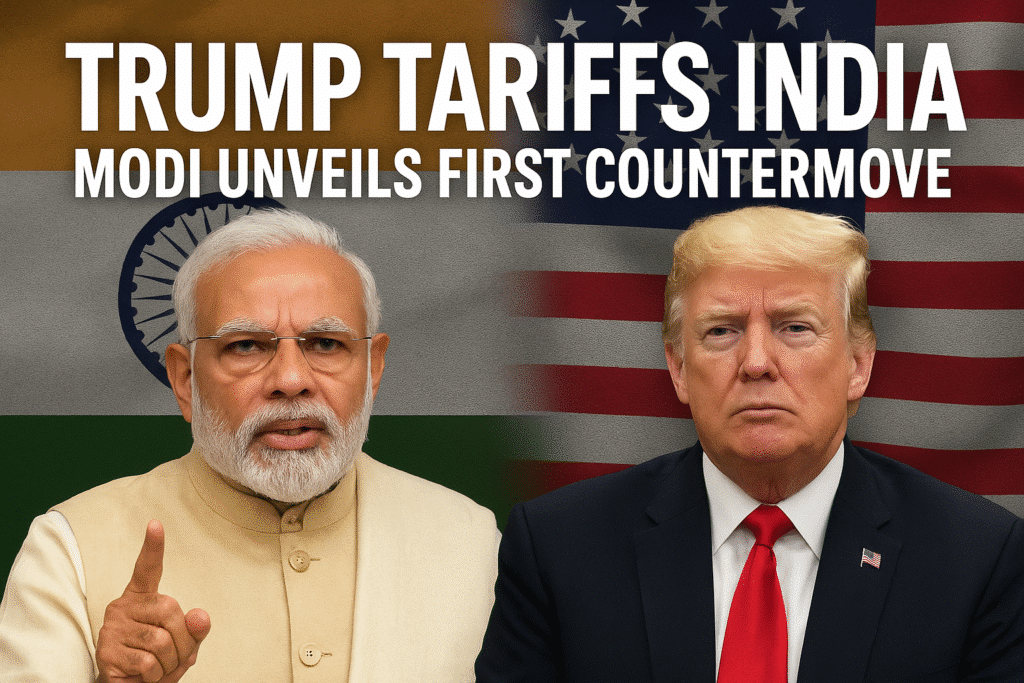Introduction
The U.S.–India trade standoff has escalated after Trump Tariffs India imposed a 50% duty on key Indian exports. In response, Prime Minister Narendra Modi announced India’s first countermove, unveiling tax relief, GST cuts, and trade diversification measures to protect industries and workers from the economic fallout.
Key Points
- Trump imposed 50% tariffs on Indian exports over Russian oil imports.
- Key sectors hit: textiles, gems, leather, seafood; pharma spared.
- India’s annual exports to the U.S., valued at nearly $86–87 billion, could shrink by as much as 43% under the new tariff regime.
- Modi counters with GST cuts, income tax relief, and trade outreach.
- India now seeks UK, EU, and Asian partners to offset U.S. losses.
Trump Tariffs India—The Trigger Point
On August 27, 2025, U.S. President Donald Trump escalated trade tensions by imposing a 50% tariff on a wide range of Indian goods. Under the new Trump Tariffs India move, U.S. duties have doubled—25% as a reciprocal tax and an additional 25% punishment for India’s Russian oil purchases.
This decision, covering nearly two-thirds of Indian exports to the U.S., threatens major industries such as textiles, gems and jewellery, seafood, leather goods, and automobiles. The U.S. excluded India’s pharma and semiconductor shipments from the Trump Tariffs India list, citing the need to protect international health supplies and critical tech markets.
Modi’s First Countermove—Relief and Diversification
Prime Minister Narendra Modi moved swiftly after the Trump Tariffs India announcement, unveiling New Delhi’s first counter-plan while denouncing the U.S. action as inequitable. His plan includes:
- Tax Reforms: Simplification of GST rules and an income tax relief package worth nearly $12 billion to support domestic industries.
- Export Assistance: Special subsidies and credit guarantees for exporters hit by tariffs, especially small and medium-sized businesses in textile hubs like Surat and Tirupur.
- Trade Diversification: Aggressive outreach to the UK, EU, Japan, New Zealand, and Middle East partners, aiming to reduce dependence on the U.S. market.
- Self-Reliance Push: Renewed emphasis on the “Atmanirbhar Bharat” (self-reliant India) agenda to boost domestic manufacturing.
Economic Fallout—Jobs and GDP at Risk
Goods worth about $86–87 billion were shipped from India to the U.S. in 2024. Analysts now warn that exports could shrink by up to 43%, potentially shaving 1% off India’s GDP growth.
In Surat, the diamond capital, industry associations say nearly 50,000 workers have already lost jobs after the first tariff wave. Now, with the 50% levy in place, another 100,000 jobs could vanish in coming months. Textile, seafood, and handicraft exporters in Uttar Pradesh, Gujarat, and Tamil Nadu also face severe distress.
Also Read: Elon Musk’s Starlink in India: 2025
Political and Diplomatic Strain
Modi’s sharp response reflects rising domestic pressure as exporters, industry groups, and state governments demand urgent intervention. India also cancelled a U.S. trade delegation visit, signaling deep diplomatic strain.
Once celebrated for their personal chemistry, the Modi–Trump relationship now shows clear cracks. Observers note that this confrontation could derail broader cooperation in defence and technology if not resolved diplomatically.
India’s Strategic Shift
The counterplan also highlights a longer-term strategic pivot. Indian negotiators are fast-tracking free trade agreements with the UK and EU, while strengthening ties with Asian economies to expand textile and jewellery exports.
Meanwhile, the Reserve Bank of India (RBI) has signalled readiness to step in with rupee trade settlements and liquidity support, ensuring exporters are not completely cut off from financing options.
Conclusion
The Trump Tariffs India dispute has triggered a serious trade and diplomatic clash, but Modi’s first counterplan shows India will not remain passive. By rolling out tax reforms and diversifying trade, India is bracing itself for a prolonged standoff while safeguarding its industries and workers.





